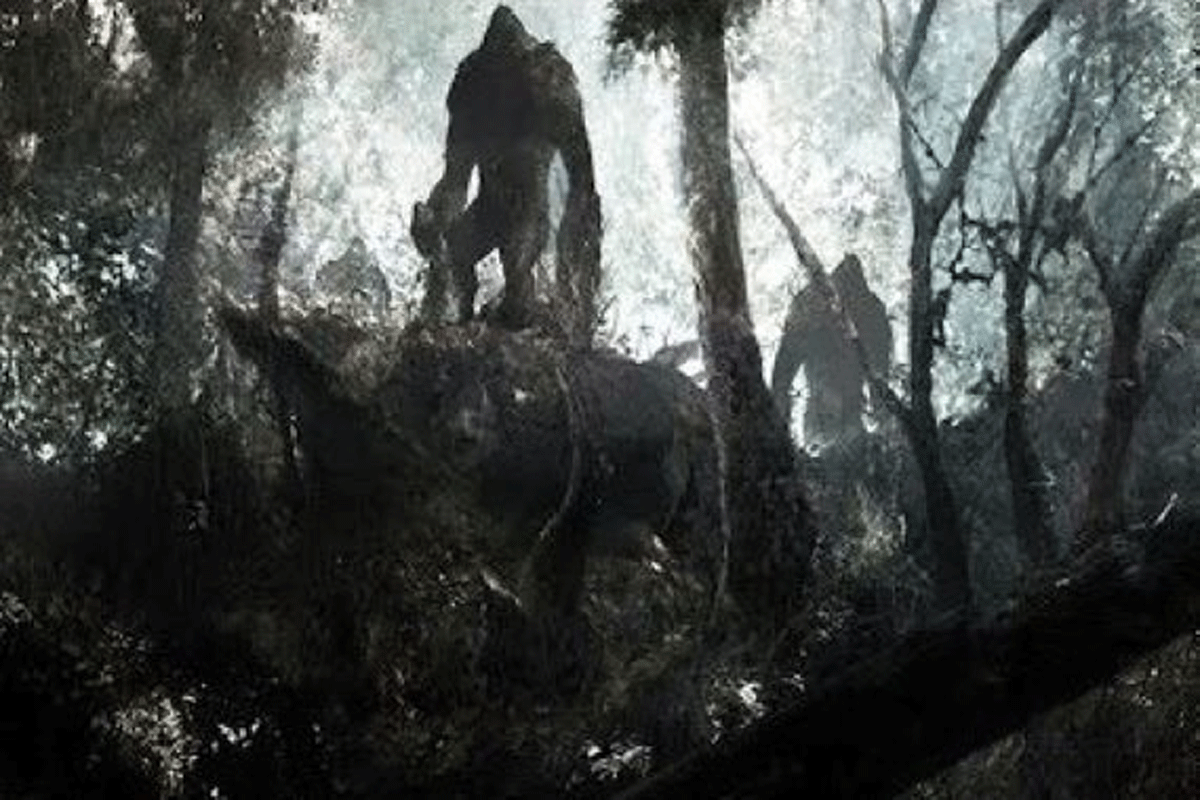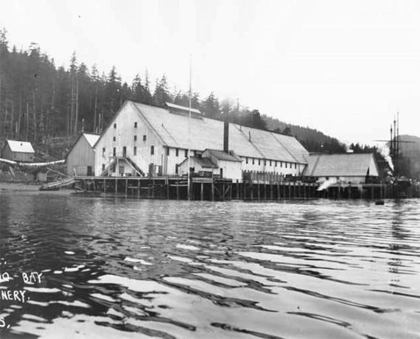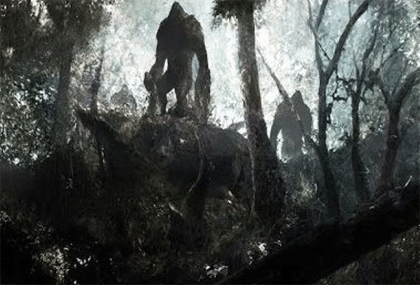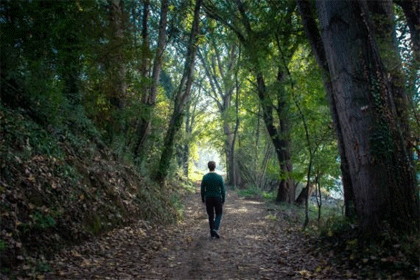
Bigfoot, vanishings, strange deaths, and the cursed abandoned town of Alaska
By Brent Swancer
OUT in the cold wilds of the Kenai Peninsula, Alaska, is a windswept array of buildings in the middle of nowhere called Portluck. From a distance through the fog it seems like perhaps a quaint, cozy town nestled along the seaside and surrounded by breathtaking vistas of scenic mountains and forests, but as you draw closer you will realize that it is actually nothing but some rotted out carcasses of buildings long uninhabited, and the twisted, rusted remains of an old cannery poking out of the shoreline like the fossil of some ancient deep sea leviathan. This was once the little paradise away from it all that one would think, a bustling seaport that managed to grow and thrive at one point. Yet this place was at some time forsaken, the inhabitants held under siege by strange forces they could not understand and could not cope with, leading to strange phenomena, mysterious deaths, vanishings, and a mass abandonment and unsolved mystery discussed to this day.
The community of Portlock was first established in 1786, with the arrival of British captain Nathaniel Portlock, from which the town derived its name. At the time the only people who lived there were mostly Native Aleuts and some Russians, and at first it was little more than a collection of huts, a serene sanctuary away from civilization and surrounded by natural splendor. It would not be until 1900 that any large scale settlement would take place here, when a salmon cannery was established along the shore of the bay. The cannery was a fairly big operation, finding vast resources of fish in the unspoiled clear waters and bringing in droves of people looking for work, growing to meet the needs of the expanding population of cannery workers willing to live in this remote, wild place. By the 1920s, Portlock was booming, yet while town thrived for some years, in the background it seems that there were dark and mysterious forces lurking in the periphery.
 The cannery
The cannery
Even before Portlock had even existed there had long been sinister stories told by the Natives of the area. They had long told of a creature stalking the wildernesses of the region which they referred to as a Nantiinaq, which roughly translates to “half man- half beast.” The Natives were apparently terrified of these creatures, and would avoid any area in which they were known to lurk. At first Portluck seemed safe, but whether the Nantiinaq had anything to do with it or not, strange things began happening in and around Portluck not long after its settlement. The first bizarre incident allegedly happened as early as 1905, just a few years after the cannery had opened. At this time, many of the workers at the cannery suddenly stopped coming to work and refused to come back, but this wasn’t due to pay or working conditions, but rather because the men were deeply spooked. They claimed that there was “something in the woods,” commonly reported by the men as being large dark shapes that would stare at them from the tree line at the shore and sometimes display menacing behavior. The workers were eventually convinced to come back the following season, but this was not the end of the town’s problems.
In the 1920s and 30s there were several mysterious deaths in the area that seemed to have been caused by something very large and powerful. The first was a local hunter by the name of Albert Petka, who was out hunting with his dogs in the 1920s when he came across a massive hairy creature that materialized from the trees to strike him in the chest, sending him flying. Petka’s dogs allegedly managed to chase the beast off, and when rescuers arrived he explained what had happened before dying from his wounds later. Natives at the time saw this as a bad sign, believing it to be evidence that a Nantiinaq had come to haunt the area. Rumors like this persisted for years, only further bolstered by stories of miners, loggers, hunters, or cannery workers of finding huge tracks in the woods, or of seeing fleeting large dark shapes and sometimes hearing eerie howls at night. Making it even more ominous is that there were some reports from frightened Natives that there was a ghostly entity in the area as well, which took the form of a woman wearing a long black dress and who would appear at the top of the cliffs near town to scream and moan before vanishing.
 In the 1930s there was another alleged violent attack in the area. On this occasion, a logger named Andrew Kamuck went off to the site as usual but was later found dead, his head bashed in by a piece of logging equipment. It was very odd, because the body was found some distance away from the actual site, and the piece of machinery used to kill him was far too heavy for any man to have even picked it up, much less drag it any significant distance. After this, things began to get rather sinister. It was reported that people began to go missing fairly regularly, going off hunting or to their jobs to never return. Stories like this sent the Natives into a panic, and many of them fled Portlock altogether. Local historian Brian Weed has said of this:
In the 1930s there was another alleged violent attack in the area. On this occasion, a logger named Andrew Kamuck went off to the site as usual but was later found dead, his head bashed in by a piece of logging equipment. It was very odd, because the body was found some distance away from the actual site, and the piece of machinery used to kill him was far too heavy for any man to have even picked it up, much less drag it any significant distance. After this, things began to get rather sinister. It was reported that people began to go missing fairly regularly, going off hunting or to their jobs to never return. Stories like this sent the Natives into a panic, and many of them fled Portlock altogether. Local historian Brian Weed has said of this:
When the 1930s incidents started to happen most of the Russian Aleuts actually moved out of town for a year. The people running the cannery basically begged their workers to come back and they set up armed guards for a short period of time, trying to get their workers back in town.
Most were eventually coaxed into coming back, but this was not nearly the end of the weirdness. People continued to disappear without a trace, and sometimes the missing were found in quite the gruesome state. In 1940 it was reported that a search party had been sent out to look for one such missing hunter, which would claim they had come across his body in a creek, mutilated and torn apart in a way not consistent with a bear attack. Other bodies would reportedly be found as well, apparently washed down from the mountains into a nearby lagoon, with others till discovered washed up on the shores of Port Chatham, all of them ripped apart and maimed as if by some immensely powerful animal. At the time there were so many people turning up in that lagoon dead that it began to truly spook the locals, to the point that they spent much time cowering indoors away from those gloomy woods.
 These disappearances and deaths coincided with a wave of sightings of large hairy creatures and less identifiable shadow entities. On one occasion a local man named Tom Larsen claimed to have seen one on the beach methodically tearing apart fish wheels, but said that when he had tried to shoot it with his rifle he had felt oddly compelled to not fire. The settlers called these things “Mountain Apes,” “Hairy Men,” or just “Devils,” the Natives called them the Nantiinaq, but whatever one called them, all of the strangeness and death spurred on a mass exodus from the area towards the end of the 1940s, and by 1951 the town was completely abandoned, leaving all of the buildings, equipment, and cannery behind. Weed has said of this:
These disappearances and deaths coincided with a wave of sightings of large hairy creatures and less identifiable shadow entities. On one occasion a local man named Tom Larsen claimed to have seen one on the beach methodically tearing apart fish wheels, but said that when he had tried to shoot it with his rifle he had felt oddly compelled to not fire. The settlers called these things “Mountain Apes,” “Hairy Men,” or just “Devils,” the Natives called them the Nantiinaq, but whatever one called them, all of the strangeness and death spurred on a mass exodus from the area towards the end of the 1940s, and by 1951 the town was completely abandoned, leaving all of the buildings, equipment, and cannery behind. Weed has said of this:
Those people did leave the town. We know when the town and post office shut down. We know that there are reported murders in the area. They called them murders, but they also included people that just went lost in those reports.” “We’re not talking about a dozen people. We’re talking like three dozen people. If we have a serial killer in the area at the time, they took out a lot of people in the course of say 20 years.
Even this abandonment was not the end of the strange phenomena in the area, as there have been Bigfoot sightings in the years since. Some examples are a man who claimed to have been chased by Bigfoot in the area in 1968, and another case in which three hunters said their camp had been circled by a menacing large creature for three nights straight. In 1990, there was apparently a Native man who suffered a heart attack, and when paramedics came to save him, he ranted, “Did it bother you? Did you see it?” There can be no doubt that this place was rather suddenly left to the elements and shunned by those who once made their living here, but what was it? Was this a serial killer on the loose, wild animals, Bigfoot, spirits, demons, or something else altogether? For now we do not know, and the decrepit ruins of what was still sits upon the bay, with the only ones knowing the true answers are the trees and perhaps ghosts.
Mysterious Universe (MU)
Mysterious vanishings at Mount Rainier
By Brent Swancer
LOCATED in the Cascade Range of the Pacific Northwest in the state of Washington is the majestic Mount Rainier. A large active stratovolcano, Mount Rainier is the highest mountain in Washington with an elevation of 14,411 ft (4,392 m), and surrounding it is a vast swath of wilderness covering 236,381 acres that has been designated as the Mount Rainier National Park. Rich with wildlife, waterfalls, subalpine meadows, glaciers, and old growth forest, the area is very popular for all manner of outdoor activities including hiking, camping, and mountaineering, attracting droves of people every year. However, Mount Rainier seems to be in a sense hungry, in that it is a hotspot for odd unsolved disappearances, and there have been many strange cases of people who have come here to never leave.
On November 11, 1997, 27-year-old Chet Hanson went out on an excursion along the Deer Creek Falls Trailhead at Mt. Rainier National Park. An avid photographer, he took with him 35 pounds of camera equipment, planning on catching some great photographs of the natural splendor of the area. He didn’t plan to be gone long, and when he left that morning, he informed his mother that he would be back home in time for dinner. The weather at the time was clear and warm, the trail he was taking well-travelled and not particularly challenging, and so there would have been no reason to suspect anything would go wrong, but Chet would never return from his trip.
 Mount Rainier National Park
Mount Rainier National Park
That night he did not come home, and when the next day he did not show up for his job at Alaska Airways he was reported as missing. Police were able to locate the missing man’s vehicle parked at the Deer Creek Falls Trailhead, and the car contained a set of negatives, including one from Highway 410 and another from the Tipsoo Lake area, as well as a set of house keys, a glasses case, and various papers, but there was no sign of Chet or his expensive camera equipment. An extensive search along the trail turned up no trace of him, and the only clue rangers got was a witness who claimed to have seen Chet at Shriner Peak at around noon on the day he had gone missing. It was thought that he had perhaps gone off trail, and so tracker dogs and personnel and volunteers were brought in to mount a more extensive search, but no trace of Chet or his equipment would ever be found, and the dogs could pick up no scent trail, as if he had just evaporated into thin air.
A few years later, in July of 1999, the national park erased another person. On July 8th of that year, 34-year-old editor with the New Press and a former editor and writer at The Village Voice, Joseph “Joe” Wood, drove out to Mount Rainier National Park to do some hiking and birdwatching. He arrived at the park at around 12:30 PM and that would be the last anyone has ever seen of him. When Wood failed to show up for an important journalists’ convention the next day, colleagues became worried and he was reported as missing. Authorities found Wood’s rental car parked at a Mt. Rainier National Park parking area, but there was no sign of what had happened to him and a search turned up nothing.
Rangers were able to get a lead when the talked to another hiker named Bruce Gaumond, who claimed to have met Wood on the day he disappeared. According to Gaumond, he had met Wood on the Rampart Ridge trail at an altitude of about 4800 feet, and Wood had asked him about how much further the snowy trail extended. The two had walked along together, but Gaumond had turned back when they reached a snow bridge. According to him, Wood had been undeterred by the snowy terrain and had continued on, and that is the last official sighting of the missing man. At the time the trails were largely obscured by snow, and it would have been fairly treacherous terrain, so it was assumed that he may have been injured or lost out in the wilderness. Search teams using helicopters and tracker dogs fanned out to scour the entire area, but there would be nothing found, and when another search was carried out after the snow had melted there was still no trace of what had happened to Joseph Wood, another person swallowed up by Mt. Rainier.
 More recently is the case of 57-year-old Eric Lewis, who on July 1st, 2010 was mountain climbing at the Mt. Rainier National Park. At the time, he was climbing with two companions, a Don Storm, Jr. and Trevor Lane, at a place called the Gibralter Ledges, on a route headed towards the mountain summit. The lead climber had been Storm, followed by Lane and then Lewis in the rear, and considering the low visibility and high winds at the time they had been tethered together in order to keep from losing each other. At one point at an altitude of 13,900 feet they decided to take a break and group together, but Lewis did not appear, and when the climbing rope was pulled up, he was not attached to it. Instead, they found on the other end a butterfly knot, and it looked as if Lewis had simply unclipped or cut himself from the rope. Why would he do this? No one knew.
More recently is the case of 57-year-old Eric Lewis, who on July 1st, 2010 was mountain climbing at the Mt. Rainier National Park. At the time, he was climbing with two companions, a Don Storm, Jr. and Trevor Lane, at a place called the Gibralter Ledges, on a route headed towards the mountain summit. The lead climber had been Storm, followed by Lane and then Lewis in the rear, and considering the low visibility and high winds at the time they had been tethered together in order to keep from losing each other. At one point at an altitude of 13,900 feet they decided to take a break and group together, but Lewis did not appear, and when the climbing rope was pulled up, he was not attached to it. Instead, they found on the other end a butterfly knot, and it looked as if Lewis had simply unclipped or cut himself from the rope. Why would he do this? No one knew.
Considering that they had seen Lewis through the mist only minutes before and he had not been far away, they thought they would quickly find him, but there was no sign of him anywhere either downhill or at the summit. He had simply vanished. Storm and Lane would then make their way back to the base camp and contact rangers, who immediately carried out a massive search of the area, and they were only able to find Eric’s backpack, climbing harness, and snow shovel in a snow cave at an altitude of 13,600 feet, slightly below the place where he had gone missing. Rather oddly, despite the snowy ground, the only footprints found of Lewis were the ones he had made while following his climbing companions, with absolutely no sign that he had broken off to go wandering away. The case is eerie in that there is no reason for him to have wanted to cut himself or otherwise remove himself from the rope, no footprints to follow, and he had completely vanished within minutes. What happened to Eric Lewis? No one knows and he has never been found.
More recently still is a case from October 9 of 2020, when an anthropologist and assistant professor at the University of Washington’s anthropology department, Sam Dubal, 33, went out on an overnight solo hike along Mt. Rainier National Park’s the Mother Mountain Loop trail, near Lake Mowich. He was a seasoned outdoorsman who had been hiking and camping all over the world, and on this excursion, he was well stocked with camping equipment and provisions. Dubal was expected to return the next day, but he never did, and a comprehensive search carried out by the National Park Service and US Air Force could not find him, nor did efforts to contact the cell phone he had been carrying turn up anything. Other hikers who had seen him along the route reported that he had seemed normal and did not appear to be having any difficulties at the time. The only thing that would be found of the missing anthropologist was a single water bottle eerily lying on the trail, and that is it. He remains missing without a trace.
 On occasion, the bodies of missing people at Mt. Rainier National Park have been found, but this has done little to fully dispel the mysteries surrounding their vanishings. On June 18, 2014, 70-year-old Karen Sykes went out hiking with her partner in the Owyhigh Lakes area of Mount Rainier National Park. Despite her age, Sykes was a very experienced hiker and mountain climber, in fact she had written books and articles on the matter and had her own hiking blog, so she was seen as a bit of an expert and knew the trails on Mt. Rainier extremely well. On this day her and her boyfriend Greg Johnston were hiking the Owyhigh Lakes Trail for the very purpose of Sykes writing an article on the trail. When they reached an altitude of 5,000 feet, Sykes told Johnson that she would scout ahead briefly and be right back, but she never did come back, which was odd since the weather was fine and they had been along the same stretch of well-marked trail countless times before.
On occasion, the bodies of missing people at Mt. Rainier National Park have been found, but this has done little to fully dispel the mysteries surrounding their vanishings. On June 18, 2014, 70-year-old Karen Sykes went out hiking with her partner in the Owyhigh Lakes area of Mount Rainier National Park. Despite her age, Sykes was a very experienced hiker and mountain climber, in fact she had written books and articles on the matter and had her own hiking blog, so she was seen as a bit of an expert and knew the trails on Mt. Rainier extremely well. On this day her and her boyfriend Greg Johnston were hiking the Owyhigh Lakes Trail for the very purpose of Sykes writing an article on the trail. When they reached an altitude of 5,000 feet, Sykes told Johnson that she would scout ahead briefly and be right back, but she never did come back, which was odd since the weather was fine and they had been along the same stretch of well-marked trail countless times before.
Johnson searched along the trail to find no sign of where she had gone, so rangers were soon notified and a search launched utilizing six ground crews, two dog teams, and aircraft, but she could no be located anywhere. It was seen as very bizarre that such a tough, seasoned hiker could have managed to get so lost on a delineated, easy trail in fair weather within minutes. The search would go on for several days, until 3 days after her disappearance the body of Karen Sykes was found in mysterious circumstances. She was discovered up steep, rugged terrain well off the trail she had been on in an area that was difficult to get to, so no one could figure out how or why she had managed to get so off the trail to end up there. Further making it mysterious was that she had no physical injuries and a clear cause of death could not be determined, with the coroner concluding that she had died of a mixture of hypothermia and a heart condition. It is rather strange, because she had been dressed well for the weather and was described by friends and family as being very physically fit for her age. It has not been determined why she would have gone off the trail when she had claimed she would be back in a minute, how she could have vanished within moments, or shy she made it up to that steep ridge to die, and it is a case that seems unlikely to be solved any time soon.
What is it about this place that draws so many mysterious disappearances to it? Is this just a result of the terrain and wilderness, or is there something else going on here? Did these people just get lost or succumb to the elements, and if so how do we explain all of the strange details involved? There is no way to really know what is going on, and at the moment Mount Rainier and its expansive national park have many strange mysteries, indeed, and people still keep a habit of coming here never to return.
MU
The strange unsolved mystery of the vanishing kingpin
By Brent Swancer
THE man named Arthur James Williams doesn’t have a background that would hint at him ever becoming a major drug kingpin or becoming a stubborn unsolved mystery. Born in 1923 in Somerset, England, when World War II rolled around he was so eager to enlist and join the fight that he lied about his age to enter military service in the British Army when he was just 17. Although records of his war years have remained a bit murky, it is known that he fought with the 1st Battalion of the King’s Own Yorkshire Light Infantry and the 5th Battalion of the Duke of Cornwall’s Light Infantry, and that he was wounded in battle, earning a medal for courageous service and sent home. In later years he would seek a new life overseas in Canada, working as a logger in in New Brunswick and Edmonton, getting married along the way and eventually going on to live in the quaint and quiet town of Ladysmith, on the southeast side of Vancouver Island, where he carved out a new career for himself making bows and arrows. So far, there doesn’t seem to be anything to suggest he would become one of the most wanted kingpins in Canada history, but it is here where his turn to the dark side would begin, sparking a compelling unsolved disappearance and mystery that has baffled to this day.
Williams’ woes began when his business went bankrupt and shut down, after which he got a divorce from his wife Margaret and began living with a new girlfriend, along the way garnering a reputation for being a rule-breaker and troublemaker. He was reportedly very adversarial with authority figures, especially police, and RCMP Staff Sgt. Bob Hawkes has said of this, “He became totally anti-establishment. He liked to cause a problem. If he could cause a problem with a policeman, he wouldn’t hesitate to do it.” Williams had a stormy relationship with the police and tax collectors for years, so he was already well on their radar when an epidemic of the drug Methylenedioxyamphetamine, or MDA, began spreading throughout Western Canada and the west coast of the United States in the 1960s. Related to the psychoactive drug MDMA, also known as “ecstasy,” it is a stimulant and hallucinogenic psychedelic, often nicknamed the “hug drug” or “Sally,” and its appearance exploded onto the scene during this time. As police scrambled to find the source and the suppliers for this scourge, their attention fell on Williams once again.
 Arthur James Williams
Arthur James Williams
At the time, Williams had moved on to working at a laboratory that he had founded for the purpose of mycology, or the study of mushrooms and other fungi. Williams’ operation was legit, as he was carrying out government-funded mushroom research, so this in and of itself wasn’t immediately suspicious, but red flags were raised when massive orders for the organic compound isosafrole began coming from there. Although not illegal in and of itself, indeed also used widely in the fragrance industry, isosafrole also just so happens to be a key ingredient in the manufacture of MDA. With such large orders placed from Williams’ laboratory, police became suspicious, ending in a raid carried out by the US Bureau of Narcotics and Dangerous Drugs, now known as the Drug Enforcement Agency (DEA). Two laboratories were raided, but at the time Williams was not convicted of any crimes for lack of evidence. However, the authorities were watching him carefully, and Williams once again aroused suspicion when he got a pilot’s license and started avidly flying his own plane back and forth from Vancouver Island to the mainland, which just so happened to coincide with a renewed surge in MDA distribution. According to authorities, this was no coincidence.
The idea was that Williams was flying his product to the mainland from his laboratory for distribution, so the Royal Canadian Mounted Police (RCMP) launched a massive investigation into Williams’ activities. Undercover cops were used to buy huge amounts of MDA, but Williams was always once step ahead, never directly involved in any of the illicit transactions. In fact, Williams proved to be extremely cunning and evasive, never giving the police anything solid to go on. Even when a shipment of gel capsules, which are a popular mode of delivery for MDA, was linked to Williams’ laboratory, it still wasn’t enough for an arrest, nor was the information gained from the phone taps that he had scoped out long ago and would even use to taunt police. The RCMP continued to monitor his activities for years, until finally the frustrated authorities decided to make the risky and unconventional decision to arrest Williams anyway and hope that a search of his property would turn up the evidence they needed to convict him.
On August 16, 1977, raids were carried out at three locations, including at Williams’ property, all while Williams ranted at the police calling them “Nazi pigs,” but the huge stash of drugs they expected to find was not there. Nevertheless, they were able to find a separate, very elaborate laboratory hidden away in a hidden room tucked away in a secret passage beneath a fortress-like structure behind the house called “The Barn,” which while not containing what the authorities were expecting, nevertheless had trace amounts of MDA and gelatin capsules. It was good enough for an arrest, and a preliminary hearing would be held. Dave Staples, head of the RCMP’s Victoria drug squad, would say of the capture, “We always respected Williams as a wily adversary. He was hard to catch. It took a lot of man-hours, a good deal of imagination, and a good deal of luck.” After the preliminary trial, Williams was released on a steep bail. However, before the trial could commence, he would vanish into thin air under very strange circumstances.
 It was reported that just days before the trial, Williams took off in his single engine Cessna airplane headed towards Vancouver to meet with his lawyer, but it never landed. It was thought that he had crashed into the Strait of Georgia, as it would turn out that he had made an emergency radio call shortly after takeoff, screaming that he had lost control of the aircraft. Searchers who arrived on the scene were able to find only scant debris, but there was no sign of Williams’ body anywhere. More miscellaneous flotsam would wash ashore, and Williams still remained technically missing and presumed dead, but no one was really quite sure. After all, he had been known as a crafty, sneaky foe, and one detective on the case would say, “There’s no doubt it was his aircraft. There’s no doubt he went down. Do I think he was killed in an aircraft accident? No. It was too good to have happened to Art Williams.” There was also the idea that not nearly enough wreckage had been found to indicate an actual crash, and that Williams had perhaps thrown it all in the water himself to cover his trail, before faking the emergency message and leaving the country to go into hiding. Others disagreed and insisted that he must have died in a crash, but it seemed suspicious as he had been such a good pilot and so slippery to catch. Even Williams’ own lawyer would say, “Art Williams, crash? He’s a fucking ace pilot. He didn’t crash.” No one could agree on what was going on, and then the mystery would deepen even further.
It was reported that just days before the trial, Williams took off in his single engine Cessna airplane headed towards Vancouver to meet with his lawyer, but it never landed. It was thought that he had crashed into the Strait of Georgia, as it would turn out that he had made an emergency radio call shortly after takeoff, screaming that he had lost control of the aircraft. Searchers who arrived on the scene were able to find only scant debris, but there was no sign of Williams’ body anywhere. More miscellaneous flotsam would wash ashore, and Williams still remained technically missing and presumed dead, but no one was really quite sure. After all, he had been known as a crafty, sneaky foe, and one detective on the case would say, “There’s no doubt it was his aircraft. There’s no doubt he went down. Do I think he was killed in an aircraft accident? No. It was too good to have happened to Art Williams.” There was also the idea that not nearly enough wreckage had been found to indicate an actual crash, and that Williams had perhaps thrown it all in the water himself to cover his trail, before faking the emergency message and leaving the country to go into hiding. Others disagreed and insisted that he must have died in a crash, but it seemed suspicious as he had been such a good pilot and so slippery to catch. Even Williams’ own lawyer would say, “Art Williams, crash? He’s a fucking ace pilot. He didn’t crash.” No one could agree on what was going on, and then the mystery would deepen even further.
Fast forward to 15 months later and Williams’ body had still not been found. His estranged wife, Margaret, petitioned to have him officially declared dead and then she followed his lead and vanished off the face of the earth without a trace as well. When her home was searched, all of her clothes and belongings were there, food was in the refrigerator, and $50,000 in cash was found lying around, baffling authorities. A massive investigation and search were carried out, but no clue as to what had happened to her turned up. Making it all even more mysterious still is that not long after this, just three months after Margaret went missing, Williams’ property, including his secret lab, would all be destroyed in a fire, the exact causes of which would never be determined. Interestingly, the new owner of the property, a Ken Heal, would report that he had been getting threatening phone calls after announcing that he had planned to make a movie on Williams’ life. Did this fire have anything to do with Williams’ and Margaret’s disappearances? Is there any connection between all of these incidents? No one knows.
The case of what has been called “The Wizard of Ladysmith” has never been solved, and indeed there have been no further leads or clues on it at all, and although the federal investigation on it is still open, it doesn’t seem likely that we will know what happened to Art Williams anytime soon. What happened to him? Was this just another of his schemes, with him escaping to leave everyone perplexed? Or did he really just simply crash and die to be lost at sea? What happened to Margaret Williams and what connection does it have, it any? What about the mysterious fire? What is going on here? At the moment the case has gone cold, the only one who knows is Williams himself, and it is all a very intriguing journey from soldier, to drug kingpin, to great unsolved mystery.
MU


















